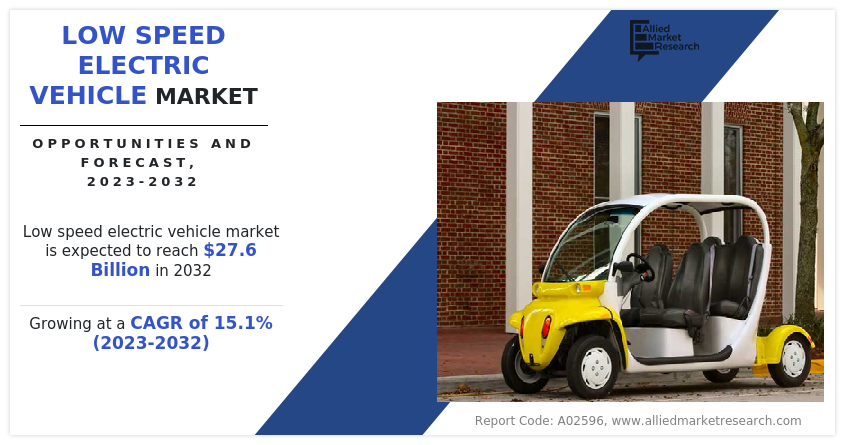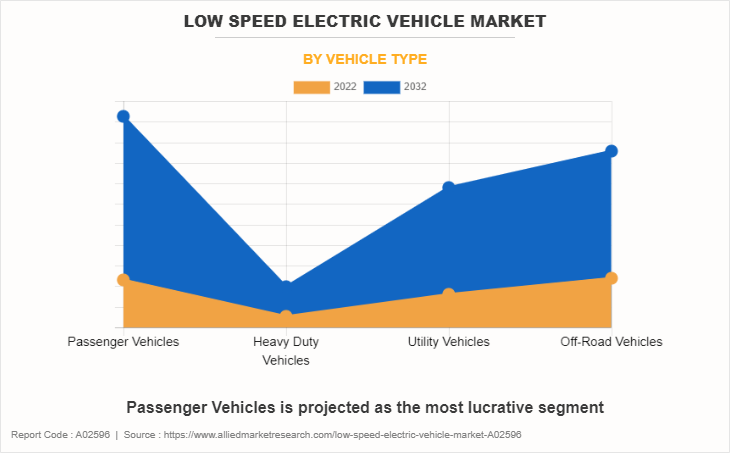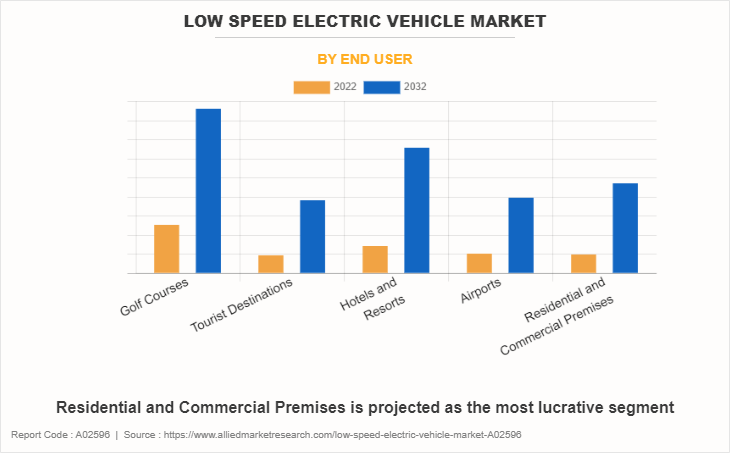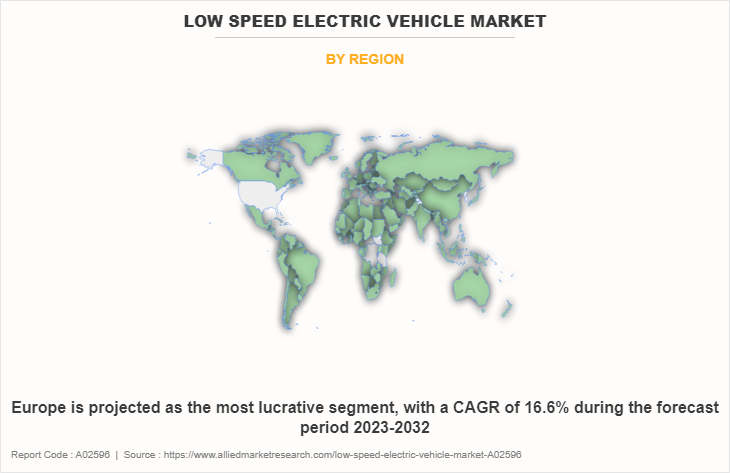Low Speed Electric Vehicle Market Overview
The global low speed electric vehicle market size was valued at USD 6.8 billion in 2022, and is projected to reach USD 27.6 billion by 2032, growing at a CAGR of 15.1% from 2023 to 2032. Factors such as stringent government rules and regulations towards vehicle emission and rise in fuel cost supplement the growth of the low-speed electric vehicle industry. However, the high cost associated with EVs, lack of proper charging infrastructure, and as the technology is still in the maturing stage are hampering the growth of the low-speed electric vehicle market share globally. However, proactive government initiatives and improvement in electric vehicle R&D and development of its batteries is predicted to create growth opportunity for the key players operating in the market.
Key Market Trend & Insights
- Passenger vehicle segment leads the global low-speed electric vehicle market in terms of growth rate.
- Residential and commercial premises segment dominates by end-user, driving large-scale adoption.
- Stringent emission regulations across EU, U.S., China, India, Japan, and Australia support EV adoption.
- Rising fuel prices push consumers toward cost-effective and eco-friendly electric mobility.
- Stable electricity costs compared to volatile fuel prices encourage EV usage.
- Technological advancements in EVs enhance consumer confidence in switching from ICE vehicles.
Market Size & Forecast
- 2032 Projected Market Size: USD 27.6 billion
- 2022 Market Size: USD 6.8 billion
- Compound Annual Growth Rate (CAGR) (2023-2032): 15.1%

Report Key Highlights:
- The report covers a detailed analysis of the low-speed electric vehicle
- The low-speed electric vehicle market has been analyzed from the year 2022 till the year 2032.
- Latest developments have been mentioned in the research study.
- Top companies operating in the industry have been profiled in the research study.
- The research study includes different segments & regions across which the market has been analyzed.
Introduction
The growth in popularity of low-speed EVs is due to stricter pollution norms and an inclining tend towards more fuel-efficient vehicles with low emissions. As EVs operate on batteries they rely on batteries as a fuel source. Recently, there has been an increasing trend utilizing new batteries such as molten salt, zinc-air, and various nickel-based designs majorly most of the EVs today use lithium-ion batteries. The electric vehicle was primarily designed to replace conventional ways of transport as they lead to environmental pollution. Low-speed electric vehicles have gained popularity owing to numerous technological advancements. The electric vehicle outperforms the conventional vehicle providing higher fuel economy, low carbon emission, and maintenance.
Market Dynamis
The market growth is driven by stringent government rules and regulations toward vehicle emissions and increases in fuel costs. In addition, the rise in pollution, technological advancements, surge in the automobile industry, and decrease in fossil fuel reserves have fueled the growth in the development and production of low-speed electric vehicles.
For instance, on June 2023, Textron Inc. launched a new street-legal Liberty LSV and model update for Freedom RXV. The newly launched models are specifically designed for golf courses and use in the neighborhood both the vehicles are street legal.
Similarly, in August 2023, Yamaha Motor Co., Ltd. developed Low-Speed Electric Mobility for first- and last-mile transportation to address the national transportation issue in Japan. The company is developing vehicles for running on public roads at speeds under 20 km/h, especially for local elderly residents.

Market Segmentation
The global low-speed EV market is bifurcated based on vehicle type, end user, and region. Based on vehicle type, the market is segmented into passenger vehicles, heavy-duty vehicles, utility vehicles, and off-road vehicles. On the basis of end user, the market is fragmented into golf courses, tourist destinations, hotels and resorts, airports, and residential and commercial premises. By region, it is analyzed across North America, Europe, Asia-Pacific, and LAMEA.
Which are the Top Low-Speed Electric Vehicle companies
The following are the leading companies in the market. These players have adopted various strategies to increase their market penetration and strengthen their position in the low-speed electric vehicle industry.
- AGT Electric Cars
- Bradshaw Electric Vehicles Inc
- Columbia Vehicle Group Inc
- GARIA
- HDK Electric Vehicle
- Polaris Inc
- Speedways Electric
- Star EV Corporation
- Textron Inc (Textron Specialized Vehicles Inc.)
- Yamaha Motor Co., Ltd.
What are the Top Impacting Factors
Key Market Driver
Stringent government rules and regulations towards vehicle emissions
Power used to move traditional vehicles is generated by an ICE engine. In a combustion engine the fuel burns in combustion chamber releasing carbon dioxide. Similarly, a combustion engine vehicle also emits other major greenhouse gases like nitrous oxide, methane, and others, leading to environmental pollution.
However, as electric vehicles utilize electric motors they don not emit any pollution.Regions such as the European Union, China, India, Japan, Australia, and the U.S have put forward strict rules and regulations related to vehicle emissions. These legislations require automakers to implement cutting-edge technologies in the product in order to reduce emission.
For example, the Clean Air Act (CAA), which was implemented in 1963 and underwent several modifications, mandates that automakers comply to emission standards in order to sell their vehicle. Similarly, The California Air Resources Board (CARB) introduced the Zero-Emission Vehicle Regulation. The regulation is designed to achieve long-term emission reduction, which supports the adoption of hybrid and electric vehicles in California and aims to achieve 100% zero emission by 2035, these regulations are anticipated to create favorable conditions for market growth.

Rise in fuel cost
In recent years, there has been a steep increase in the price of crude oil, majorly due to the price of crude oil being controlled by the OPEC countries. This resulted in an increasing shift of people towards cheaper and eco-friendly modes of transportation.
In contrast to a steep increase in fuel prices, major countries around the world have seen a decline or stability in price of electricity. For a country that is heavily dependent on fuel-based automobiles, there has been an increasing trend towards the use of EVs. Moreover, as technology is continuously developing, consumers are believing EVs as an alternative to traditional ICE vehicles.As a result of this, the growth of the market is due to an increase in the price of fuel and the inkling preference of users towards electric vehicles.
Restraints
High cost of electric vehicles
High vehicle prices are a major barrier to low-speed electric vehicle market growth. Batteries and other car technology used in EVs are expensive. Modern EVs also use lithium-ion batteries and other advanced driving technologies, which increases the cost of low-speed electric vehicles and slows market growth. Governments worldwide are providing tax exemptions and subsidies to promote electric vehicle adoption. This initiative is projected to boost electric vehicle sales during the review period.

Opportunities
Proactive government initiatives
Growth of urbanization and rise in attractive incentives for electric vehicles from various governments are expected to present lucrative opportunities for the expansion of the market. Due to consumer inclination toward electric vehicles, there has been robust growth in the development of public charging infrastructures, vehicle maintenance infrastructure, battery recycling, and more.
For instance, in India, according to data from the Ministry of Road Transport and Highways, there were a total of 1,037,011 electric vehicles registered within the country, accounting for 6.4% of the total automobile sales. The increase in sales is majorly due to increase in adoption of cars for commercial and personal use. Moreover, in 2021, the government released a handbook guide to EV infrastructure in India the focuses on the development of infrastructure in the country. In 2021, the publicly accessible charging station accounted for 900 in India, which jumped to nearly 11,000 in 2022. Countries around the globe are fostering the development of EVs, which is expected to provide opportunities for the low speed electric vehicle market share during the forecast period.
Key Benefits for Stakeholders
- This report provides a quantitative analysis of the market segments, current trends, estimations, and dynamics of the low speed electric vehicle market analysis from 2022 to 2032 to identify the prevailing low speed electric vehicle market opportunities.
- The market research is offered along with information related to key drivers, restraints, and opportunities.
- Porter's five forces analysis highlights the potency of buyers and suppliers to enable stakeholders make profit-oriented business decisions and strengthen their supplier-buyer network.
- In-depth analysis of the low speed electric vehicle market segmentation assists to determine the prevailing market opportunities.
- Major countries in each region are mapped according to their revenue contribution to the global market.
- Market player positioning facilitates benchmarking and provides a clear understanding of the present position of the market players.
- The report includes the analysis of the regional as well as global low speed electric vehicle market trends, key players, market segments, application areas, and market growth strategies.
Low Speed Electric Vehicle Market Report Highlights
| Aspects | Details |
| Market Size By 2032 | USD 27.6 billion |
| Growth Rate | CAGR of 15.1% |
| Forecast period | 2022 - 2032 |
| Report Pages | 324 |
| By Vehicle Type |
|
| By End User |
|
| By Region |
|
| Key Market Players | GARIA, Star EV Corporation, Bradshaw Electric Vehicles, Inc., AGT Electric Cars, HDK Electric Vehicle, SpeedwaysElectric, Textron Inc. (Textron Specialized Vehicles Inc.), Columbia Vehicle Group Inc., Yamaha Motor Co., Ltd., Polaris Inc. |
Analyst Review
The low speed electric vehicle functions on electricity and does not use conventional fuels, such as gasoline or diesel, as its power source. Moreover, the usage of alternative fuel and electricity in these vehicles leads to zero emissions, making them ecofriendly. The advent of low speed electric vehicles is a paradigm shift in the modern world. Automobile manufacturers are inclined toward electric and alternative fuel vehicles due to increase in vehicle emission regulations. The low speed electric vehicle market is in its maturity stage and contributes significant revenue in the overall automotive industry.
The market growth is driven by stringent government rules and regulations toward vehicle emission and increase in fuel costs. In addition, rise in pollution, technological advancements, surge in automobile industry, and decrease in fossil fuel reserves have fueled the growth in the development and production of low speed electric vehicle. High vehicle cost and lack of proper charging infrastructure are some of the major restraining factors of this market. Furthermore, proactive government initiatives and technological advancements in electric vehicles ensure lucrative growth opportunities for this market globally. This can be attributed to rise in the sale of automated vehicles globally. These features offer lucrative opportunities for the low speed electric vehicle demand globally.
Among the analyzed geographical regions, currently, North America is the highest revenue contributor and is expected to dominate during the forecast period, followed by Europe, Asia-Pacific, and LAMEA. This growth is attributed to the increase in demand for electric vehicles for various types of vehicles ranging from low-end passenger cars to heavy load commercial vehicles.
Fast charging are the upcoming trends of Low Speed Electric Vehicle Market
Golf courses are leading application of Low Speed Electric Vehicle
Asia-Pacific the largest regional market for Low Speed Electric Vehicle
The Low Speed Electric Vehicle market was valued at $6,844.0 million in 2022
Polaris Inc, Textron Inc , and HDK Electric Vehicle are the top companies to hold the market share in Low Speed Electric Vehicle Market
Loading Table Of Content...
Loading Research Methodology...



